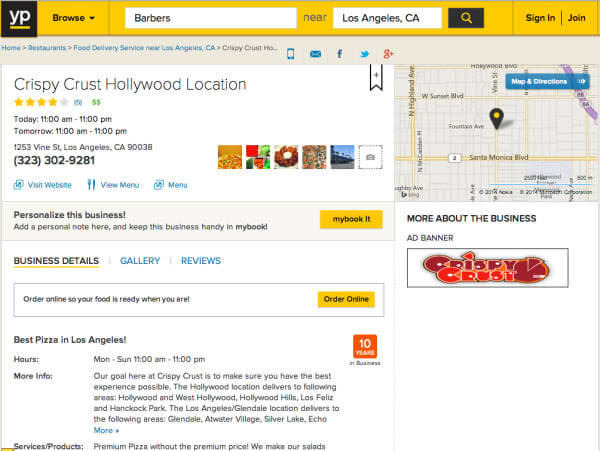Top 10 Tips For Local Search Success
Many local businesses today are overwhelmed by the variety of local marketing choices available. Unlike the old days when a small handful of advertising outlets would cover the majority of your audience, the sheer volume of marketing options has seemingly flattened the reach of each advertising channel. Business owners see all the different ways that […]
Many local businesses today are overwhelmed by the variety of local marketing choices available. Unlike the old days when a small handful of advertising outlets would cover the majority of your audience, the sheer volume of marketing options has seemingly flattened the reach of each advertising channel.
Business owners see all the different ways that consumers are seeking out, discovering and considering local businesses, and they don’t know where to start.
The key to getting started is building a strong foundation for local search success by checking off the basics. From there, you can take advantage of other opportunities, including paid media, to generate even greater visibility for your brand.
Here are my top 10 tips for best positioning your business in local search:
1. Ensure Key Information About Your Business Is Accurate & Accessible
One of the most important aspects of local search is ensuring that your business’ information is consistent, accurate and accessible throughout the web. Yet 50% of small businesses have inaccurate online listings, according to a survey by ConstantContact. If your business information is outdated or appears in different ways in different places, it will not only lower your visibility in search — it will make it difficult or even impossible for potential customers to find you.
A good approach to tackling this issue is to take advantage of local listings services, including Localeze, Axiom, SinglePlatform, Yext and Universal Business Listing to actively manage your business information across local search platforms.
For the most popular sites such as Yelp, Google, YP.com, Yellowbook.com and Dexknows, be sure to manually claim your listings and make any necessary edits directly right away.
2. Populate Your Top Local Business Listings
Once your basic information on local search platforms is accurate, build out your listings on the most popular sites to include additional information that potential customers are looking for.
The 2013 results from our forthcoming Local Search Association/Burke Inc.’s “Local Media Tracking Study” show there is a variety of information beyond business name, address and phone number that consumers are looking for when reviewing a local listing.

Source: Local Search Association & Burke, Inc., “Local Media Tracking Study,” June 2014
Over half of consumers are interested in hours of operation, website address, and pricing information. Additionally, more than one in three consumers (38%) are looking for online reviews (more on that later). It’s also valuable to add business photos, menus and service offerings and other relevant information to fill out your local business listings.
Building out your listing is easy, so set aside time to do it and do it right. And if anything with your business changes — e.g., you go from limited hours on Sundays to none at all — be sure to update that on your local listings quickly so that customers don’t show up to your empty business.
3. Build A Website With The User Experience As The Key priority
A business website is the leading component of any business’ local marketing strategy – it’s essentially the “home base” from which digital interaction with your business begins and ends. The website is the most important place for existing and potential customers to learn about your company before deciding on whether to move forward with a purchase.
Local businesses benefit when they invest in developing a contemporary, appealing, easy-to-use website. This includes using a visually appealing color scheme and attractive visual content (more on that below), as well as incorporating straightforward navigation.
A user’s experience on your business website should mirror the experience you want customers to have with your business overall. Outdated information, dead links and long page load times should never be considered acceptable. Additionally, avoid using Flash media on your business website since it may negatively impact your site’s search ranking potential and not load on some browsers and smartphones.
4. Optimize Your Website For Search

Basics for boosting business website SEO include:
- Ensure your website title goes beyond your business name to also include what it is and where it’s located. For example, if your business is called “Wesley’s Oasis,” it will be difficult for search engines to pick up on the fact that it’s a spa located in Austin if that’s all you include in your title tag. Make sure that potential customers can find your business in search by listing all relevant information in the website title: “Wesley’s Oasis – Full-Service Spa – Austin, Texas.”
- Create individual pages for each business location as well as each product or service your business offers. This will raise the visibility of each in search, making it easier for potential customers to find exactly what they’re looking for.
- Use keywords and phrasing that potential customers are most likely to use. Don’t go overboard trying to “keyword-stuff” every page, but don’t use industry lingo to explain an offering that the average Joe would describe — and therefore search — differently.
- Don’t leave contact information just for the Contact page. Include basic business name, address and phone number information on every page of your website. This not only boosts SEO, but also makes it easier for a potential customer to contact or visit your business.
5. Start A Blog To Provide A Steady Stream Of Content
An easy way to build your website’s local search visibility is to start a blog, which will provide a steady stream of new and relevant content for your site. A blog — which can be featured prominently on your website homepage as well as promoted in your business’ social media channels — is a great opportunity to provide thought leadership on your industry and highlight new business offerings.
This additional fresh content will raise your site’s SEO results and provide an ongoing mechanism to drive traffic from the social web to your site.
6. Leverage Visual Content, Including Photos & Videos
In this age of Instagram and Pinterest, visual content plays an important role in appealing to potential customers. Consumers today are attracted to large photos and engaging videos that demonstrate a brand’s authenticity and value. Both photos and videos also help to boost website SEO and improve visibility for local listings.
Basics for integrating photos and videos include:
- Add large, compelling photos to your website homepage that illustrate the character of your brand and the diversity of your offerings.
- On the homepage or the About Us section of your website, add a short “Welcome” video introducing the visitor to your business so they can see who you are and develop a level of trust with your business.
- Incorporate photos and videos into products and offering pages on your website. Consider short how-to videos and the like to demonstrate how useful the product is, or how easy it is to put together, etc.
- Add photo albums and videos to your social media pages (more on social media later). This will boost visibility for your updates and provide followers with rich content about your business.
If your business hosts photos on Flickr or videos on YouTube, you will also benefit from the opportunity to include a variety of keywords that link your content back to your business.
7. Ensure Your Business Website Is Mobile-Friendly

Start by conducting a mobile audit of your current website to determine the types of mobile consumers that are visiting your website, and what they’re looking for when they access your site. Then work with a mobile website developer to create a slimmed down version of your desktop website that highlights the most important information potential customers are looking for, delivered in a format that is easily viewable across smartphone devices.
Additionally, use call-to-action messaging throughout the mobile site to make clear what consumers can accomplish via your mobile website, such as schedule appointments or purchase products. Use large, bold text that is easily viewable on a mobile screen.
8. Engage On Social Media Channels Used By Your Target Customers
Social media provides a way to keep in direct, ongoing contact with your business’ most loyal customers about new offerings, promotions and the like. Profiles on Facebook, Twitter, etc. also rank high in online search and create backlinks to your website, boosting your website’s visibility. These benefits come at no added cost to your business.
Begin by determining which social media channels make the most sense for your business, based on the types of content you will be able to share and the channels your potential customers are most likely to be using.
Then create an editorial calendar for what content you’ll post and when, such as promotions, giveaways, photo round-ups, new offering announcements and blog updates. Use posts to link to your business website to drive traffic. And always engage with users directly about their questions or concerns.
9. Encourage Reviews To Add Credibility To Your Business

But while you want to encourage customers who have a positive experience with your business to leave reviews, you don’t want to improperly incentivize them or even bully them to do so.
Instead, use a soft approach by featuring a list of top review sites on your website and asking customers to share their feedback with you. Print phrases such as “Let us know how we’re doing” or “Please leave your feedback” on your receipts or invoices. Even consider adding a review button in your business email signature.
10. Pay Attention To Your Success – And Adjust Your Approach As Necessary
Once you begin implementing these tips, keep close track of your progress. Create a regular and ongoing reporting method so you can see what’s working, and what needs to improve.
By building this framework, you’ll be in greater control — and achieve peace of mind about your local marketing strategy.
Opinions expressed in this article are those of the guest author and not necessarily Search Engine Land. Staff authors are listed here.
Related stories

